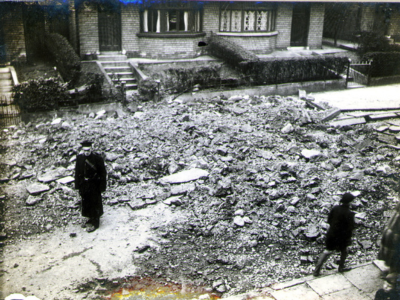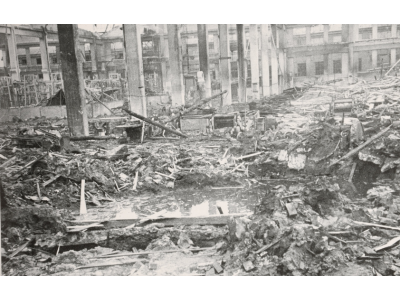The Belfast Blitz
The Dockside Raid
Despite the ambivalence to the threat of air attack, a shift in German strategy in 1941, targeting coastal port towns such as Liverpool and Clydebank, led to the first bombing raid on the city. Belfast had been identified as a principal industrial target by January 1941, though targets in the city had been identified on German planning maps by 1940.
Nevertheless, the threat of air attack was still not fully appreciated, as on the night of the first attack, 7-8 April 1941, the lighthouses on Belfast Lough were still operating as in peacetime.
The raid was part of a massive assault as 517 sorties were flying from Luftwaffe bases in France, the Low Countries, and Norway. The primary targets were the industrial centres at Glasgow, Greenock, and Clydeside, but German weather forecasting proved poor, as cloud cover was near total over the primary targets. Consequently, over half of the enormous bomber force sought out secondary targets. Conditions over Belfast were near perfect for attackers, with clear skies up to 20,000 feet, a half-moon and light winds. The German aircraft had little difficulty finding the city.

The number of aircraft that attacked the city remains unclear, but 13 radar tracks were recorded over Belfast that night. The early warning system failed to alert the population as the German aircraft approached. Indeed, reports after the raid noted how people were first alerted by the sound of exploding bombs, followed by the crack of anti-aircraft guns. Only after these did the air raid sirens sound the warning.
The attack began around midnight and lasted three and a half hours. Dazzling flares slowly descended on parachutes, illuminating the city. The bombers dropped a mixture of high-explosive bombs and incendiaries, hitting their targets in the harbour estate. Soon, storage yards filled with wood, tar, and grain were ablaze. When fire crews managed to reach the scene around 1:30am, firefighters could do little to control the inferno that had spread to surrounding buildings. As well as the storage yards, the Short & Harland fuselage assembly factory at the Alexandra Works was devastated by high explosives and incendiaries, destroying 50 partially, assembled Stirling fuselages and significantly impacting Stirling bomber production.

The defensive fire directed against the raid was limited, and the German pilots considered the response weak and ineffective. The first aircraft arrived at 5,000 to 6,000 metres, but later, aircraft descended to as low as 2,000 metres, just above the balloon barrage, as they had little to fear from the desultory anti-aircraft defences.
The all-clear was sounded just before 4:00am. Fire crews extinguished most fires soon after, but the largest continued to burn late into the evening.
BBP9 Interviewee Dorothy Clements remembered the hours after the raid:
'We got under the stairs and then after the all-clear we went back to bed again and my father thought he would check up outside in the morning when he got up. And here he found a slate from our roof lying at the side of the house, so we got the air raid warden and [he] went up to our roof space and found an incendiary bomb... which hadn't gone off. My mother and father and I had been sleeping under it not aware of it.'
In total, 13 people were killed during the raid, and over 80 were wounded. A 14th person died later in hospital of their injuries.
The attack's small scale, accuracy, and limited casualties fostered a false sense of security. There were reports of many watching the raid and the ensuing fires from their doorsteps, with one report describing the onlookers behaving as spectators at a football match. The imaginative reporting by the press of a 'wall of steel' protecting Belfast portrayed a defensive posture that was far from reality.



